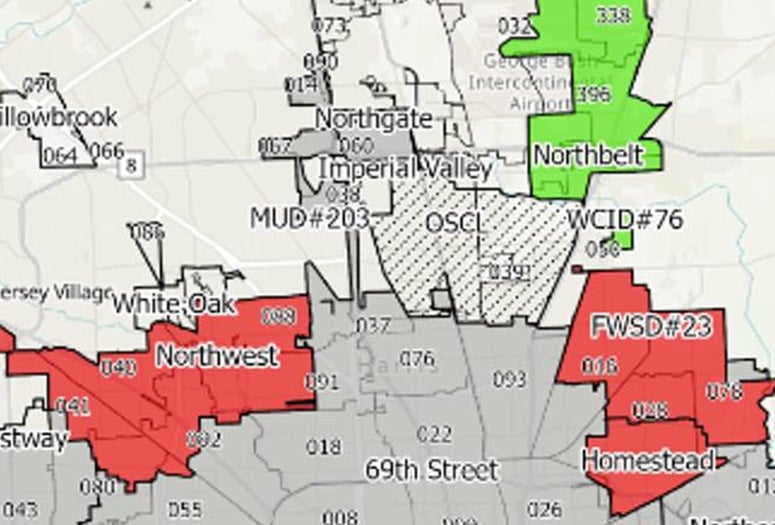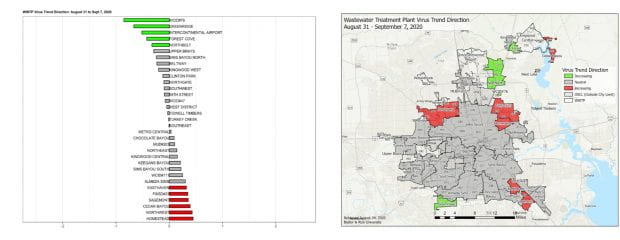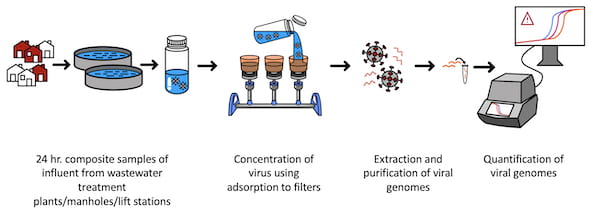Scientists and statisticians at Rice University’s Brown School of Engineering have worked long hours for months to help the city of Houston monitor the spread of COVID-19 through traces of the coronavirus found in wastewater treatment plants.
The virus responsible for COVID-19 can be found in stool regardless of an infected person’s symptoms, so treatment plants have emerged as a reliable source of data about how it has moved throughout the city. Working with Baylor College of Medicine, Rice experts have been helping track disease dynamics in close to real time by monitoring the city’s 39 plants.
“This innovative project equips the Houston Health Department with localized data that indicates where a COVID-19 outbreak may be occurring before it shows up in viral test results,” Mayor Sylvester Turner said. “Ultimately, the goal is an early warning system that allows the health department to identify problem areas sooner and put measures in place to slow the spread.”
Officials said those measures would include increased testing, outreach and education.
“Tracking the virus in wastewater provides an unbiased estimate of the extent of the virus compared with relying solely on clinical testing,” said Loren Hopkins, chief environmental science officer for the Houston Health Department and a professor in the practice of statistics at Rice. “The hope is to continue using this method to help inform public health decisions regarding interventions to control the virus.”
The data clearly shows Houston’s viral load has trended downward since July 1, matching rates from testing, according to the city.
The strategy is a viable way to essentially test an entire community at once, said Katherine Ensor, the Noah G. Harding Professor of Statistics, whose team built the statistical models that draw a comprehensive picture of viral trends in greater Houston. Work by the Rice team aligns with goals outlined in Rice’s Vision for the Second Century.
“The models provide a weekly trend analysis for each wastewater plant, an overall trend analysis and a comparison with cases from COVID-19 testing,” Ensor said. “But the wastewater gives us a more complete picture than testing because it accounts for everyone, not just people who get tested. We also see evidence that viral load in wastewater is a leading indicator for increases in our communities.”
The fact that the weekly samples come from so many plants gives the science teams excellent data -- and a lot of it.
“Many cities have a handful of large centralized facilities,” said Rice scientist and project lead Lauren Stadler, an assistant professor of civil and environmental engineering. “Houston’s 39 facilities range in size from quite small ones that serve a few thousand people to extremely large ones that serve over half a million.
“We collect samples with the help of Houston Water every week and analyze each of these for the virus concentration,” she said. “Because there are 39 plants, we have spatial resolution that allows us to identify specific areas that are experiencing a higher burden of infection and areas that may be experiencing rapid community spread.”
The Rice and Baylor labs test the same samples for the presence of the virus using slightly different methods to see if their results agree with each other. Ensor and her students then put those results into statistical perspective and deliver them to the city.
Hopkins pitched the project early this year, acquiring seed funding with Stadler and Ensor in the first round of grants from the Rice COVID-19 Research Fund and then securing additional funding from the city.
Sample collection is a major effort, she said. Every Tuesday, wastewater is collected over the course of 24 hours and delivered to the Rice and Baylor labs, which process samples from each of the 39 plants. Those plants serve 2.1 million people spread over 670 square miles.
“We do triplicate samples at each lab, and then Kathy combines that information into an estimate for the city,” Hopkins said. “What sets us apart is our collaborative team of experts. Lauren brings expertise in wastewater systems and wastewater microbiology, Kathy brings expertise in time-series and geospatial statistical analyses and Anthony Maresso (from Baylor College of Medicine) brings expertise in viruses.
“It took time to get all the steps right, and we’re still refining them, but we started getting a really good understanding of the data in July,” she said.
Hopkins noted Phil Bedient, the Herman Brown Professor of Engineering and director of Rice's Severe Storm Prediction, Education & Evacuation from Disasters Center, is helping analyze how wastewater flows through the city's sewer system and how the transport of wastewater to the treatment plants impacts the virus concentrations measured there.
Stadler said several other American cities are mounting similar programs, but Houston is unique for its large number of plants, which help pinpoint outbreaks.
“I think we’re pretty far ahead of the curve,” she said. “Not too many cities have the complexity we have. And we have two different labs to ground truth everything.”
Stadler expects the next step will be to refine the spatial data by taking samples directly from the sewer system in selected neighborhoods including, for instance, long-term care facilities. She will continue to advise Houston Health Department scientists when they take over wastewater analysis once Rice’s contract with the city ends on Dec. 31.
In a way, Rice scientists and engineers were on the case well before the virus appeared, working on ways to analyze antibiotic resistant bacteria and genes in wastewater, an issue that became more important after Hurricane Harvey, Stadler said.
“When COVID-19 hit, we basically shifted entirely to working on this, and it’s been a huge effort because of the time-sensitive nature of the data,” she said. “It’s not useful to the city unless we can turn it around quickly, and one of our biggest efforts now is to reduce the turnaround time.”
Houston officials say wastewater testing started in May and resulted in additional viral testing at several residential settings.
“At a time when fewer people are getting tested, this project helps us see what’s happening in the city,” said Dr. David Persse, health authority for the Houston Health Department. “People still need to go out and get tested, but this project gives us data that serves as another tool to identify disease, slow the spread and save lives.”






